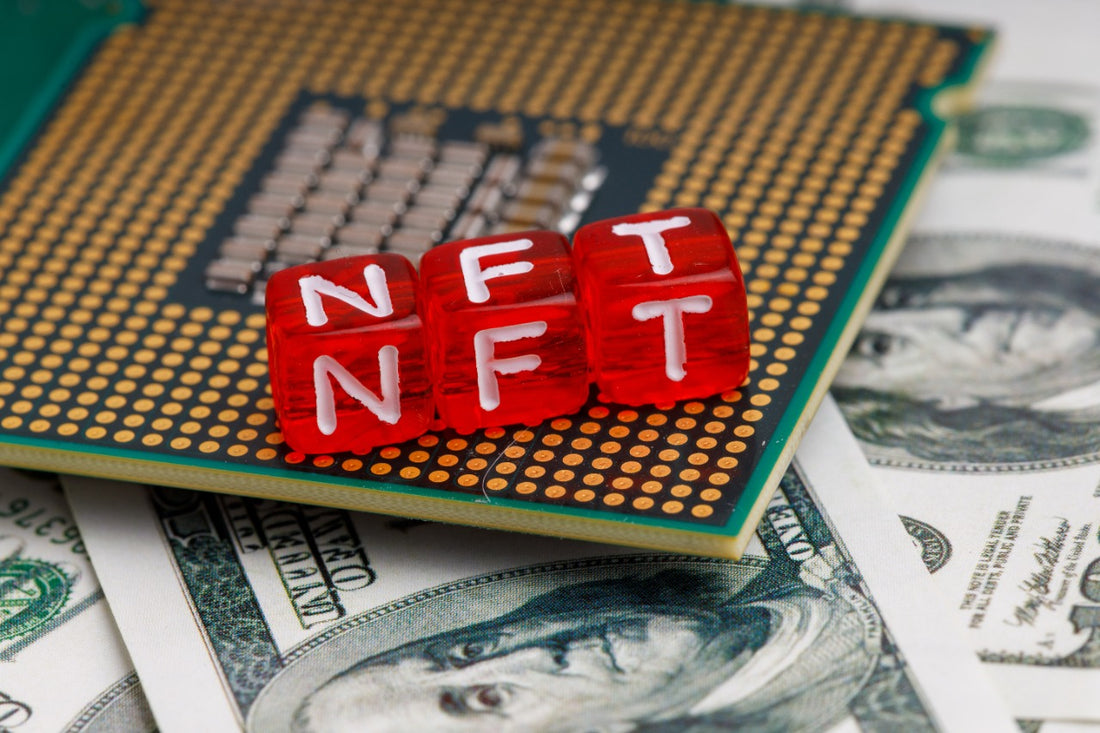Author: Aarang Chakma
NFTs are one-of-a-kind digital tokens that serve as proof of asset ownership. To ensure transparency surrounding authenticity and ownership, these tokens may be safely exchanged, with transaction history logged to a blockchain - a decentralised, digital public ledger.

Photo by Andrey Metelev on Unsplash
NFTs are typically associated with digital assets like images or videos, but they are also used to register the ownership of tangible items such as real estate, artwork, and, increasingly, clothing.
So, what exactly is an NFT in the fashion industry? Fashion NFTs can take numerous forms, including virtual clothes that buyers can wear within virtual worlds, digital content that owners can interact with, and digital twins of real physical creations.
The long-awaited meta-economy will open up new avenues for marketers and influence how people interact, shop, and socialise. Experimenting with NFTs allows you to augment your physical product with a digital layer. In other words, physical purchases that unlock in virtual worlds. Customers will soon purchase branded things for themselves and their digital avatars.
"Phygital" fashion goods have been around for a while. In February of last year, virtual sneaker company RTFKT Studios sold over $3 million USD in a limited-edition drop that featured both a physical pair of polychrome sneakers and an NFT that corresponded with the shoe. Of course, the unique NFT is worth far more than the shoe itself.
Another example of a "phygital" product is the Balmain x Barbie collaboration that debuted in January. The NFT release premiered in auction-style, with three separate digital dolls dressed in monochrome pink clothes decorated with the French fashion house's monogram design. The co-branded collection also included a full range of physical items, such as dresses, T-shirts, coats, and shoes, which were available for purchase offline.
With multiple platforms allowing artists to manufacture and sell digital fashion, NFTs and digital fashion have become key tools for businesses to establish relevance and buzz. While certain luxury labels, such as Gucci, have collaborated with platforms and individuals to develop digital clothes, people frequently make and sell products that look to be made by premium brands but are not. Consider Roblox, a metaverse and gaming platform where Gucci, Stella McCartney, and Nike have sold digital items; users can also purchase what appears to be Burberry, Chanel, Prada, Dior, and Louis Vuitton, despite the fact that these brands did not appear to be involved in the creation or sale of the majority of these items.
So how is the fashion industry adapting to the new NFT Trend?
Brands are integrating fashion and NFTs together in a variety of imaginative ways, from phygital goods that increase the traceability of rare and costly clothes to virtual objects that buyers can buy, wear, and collect in the digital realm.
-
Augmented reality clothing
Although an NFT is a digital asset, many consumers prefer to wear the clothing they buy. This is made feasible by the use of augmented reality, which superimposes digital pictures over real-world camera video.
AR fashion is becoming increasingly popular, with companies like DRESSX and XR couture producing expensive digital clothing that buyers can 'wear' using AR. Retailers like GAP are also experimenting with virtual try-on technology.

Brands are increasingly combining augmented reality with NFT technology to create clothing that customers can collect, wear, and trade. Nike and RTFKT, for example, just released Nike Dunk Genesis Cryptokicks, a set of 20,000 NFT shoes that owners may see in real life by using a Snapchat filter.
Similarly, Rebecca Minkoff collaborated with fashion NFT marketplace The Dematerialized to create a range of NFT outfits that clients may engage with using their smartphone cameras.
-
Metaverse fashion
Customers may even wear their digital products across the metaverse, with developing blockchain-backed worlds like Decentraland and The Sandbox claiming millions of registered members.

The first Metaverse Fashion Week, held within Decentraland, demonstrated fashion's interest in the metaverse. Over 70 labels, including Tommy Hilfiger, Dolce & Gabbana, and Karl Lagerfeld, took part in branded catwalks, displaying partnerships with notable digital designers, during the NFT fashion event. Several firms took advantage of the chance to market NFT gear for customers to outfit their avatars in. Tommy Hilfiger, for example, provided digitised copies of its renowned designs, such as logo sweatshirts and varsity jackets.
-
Virtual stores
In order to market towards young consumers, fashion brands have purchased a few NFTs of their own, often in the form of virtual land where they may establish stores and showrooms.
Users may purchase plots of land in the form of an NFT in virtual environments like The Sandbox, and premium businesses like Gucci have already set up shop. Gucci plans to develop an interactive fashion experience based on Gucci Vault, the premium brand's conceptual environment, in collaboration with the platform.
In the metaverse, Gucci is not alone. Selfridges, for example, has recently created the world's first NFT department store within Decentraland, where users may view unique NFTs as well as explore Selfridges merchandise.
-
Digital twins
According to a Scalefast survey, 25% of buyers who are interested in purchasing an NFT would be more inclined to do so if it was accompanied by a tangible item. Many firms, unsurprisingly, integrate NFTs with a real product that customers can touch and wear.
Dolce & Gabbana's record-breaking Collezione Genesi, the first premium NFT collection to combine both digital and physical works, is a perfect example of this. Winning bidders received both a real and virtual version of the design after paying $5.7 million at auction. Another example is Nick Graham, which has recently debuted its NFT/AR outerwear collection. Purchasers may verify their garments on the blockchain and use it to access special AR experiences via a QR code embroidered into each product.
Overpriced, for example, is leveraging NFT technology to increase traceability; their physical NFT-linked hoodie can be scanned to establish authenticity and ownership through the blockchain.
-
Exclusive content
Fashion brands are searching for opportunities beyond virtual clothes like taking inspirations from the success of image-based NFT ventures like Bored Ape Yacht Club.
In reality, the industry's first big venture into the field was a four-minute video inspired by Gucci's Aria collection, rather than a wearable NFT. Since then, the premium label has released the 'Gucci Grail' NFTs, which contain brand-inspired avatars based on 11 popular collections, including World of Women and Cool Cats. Adidas has done similar partnerships, adding its name to well-known collections such as Punks Comic.
Similarly, fashion brand MANGO recently launched an NFT collection inspired by Spanish painters Joan Miró, Antoni Tàpies, and Miquel Barceló, which featured a variety of MANGO outfits. Rather than selling the collection, which was created to commemorate the inauguration of its New York flagship store, the company will display it in its physical and virtual stores to engage with young consumers.
-
Video game collectible
According to Statista, 61 percent of Chinese Gen Z consumers buy luxury products in the 'pursuit' of fashion, while 24 percent believe these items serve as an identity statement and 45 percent believe they bring confidence. Taking advantage of the luxury consumer's passion for collecting and exclusivity, companies have teamed with video game developers to offer rare NFT collectibles to their virtual worlds.
Burberry has created a range of (virtual) vinyl toys in the digital world of Blankos Block Party, becoming the first premium brand to do so. Similarly, Louis Vuitton chose to develop its own game in which players explore the digital world and gather 30 embedded NFTs. Players that gather enough are entered into a raffle to win an ultra-rare NFT, which is transferable between platforms and may be used as a distinctive avatar on social networks.
The desire for digitalisation drives NFTs in the fashion industry
As Generation Z consumers are more keen towards digitization and personalisation, NFTs will undoubtedly play an important role in the future of fashion, especially as the metaverse evolves to provide new outlets for customers to exhibit their digital purchases.
According to a report by Epsilon, companies that provide personalised experiences to customers are more likely to be purchased by 80 percent of them. An NFT is technically a digital record registered on a blockchain, but for consumers, it's a chance to engage with companies they care about and enjoy unique experiences in the digital format they like.
So we can say that a vibrant community exists behind every successful NFT initiative, where customers can interact with your brand and supporters may form a deep and lasting bonds with one another. Customers who own your company's digital collectibles have a financial incentive to bring more people with them and become genuine brand advocates. According to Shopify's 2022 Future of Commerce research, 40% of companies want to provide additional methods for customers to connect with them in 2022 and beyond.
On that note, we can infer that we are on the verge of a new digital revolution. NFTs and the metaverse are introducing new economic opportunities and risks. Many of these new advances are being spearheaded by the fashion industry.

